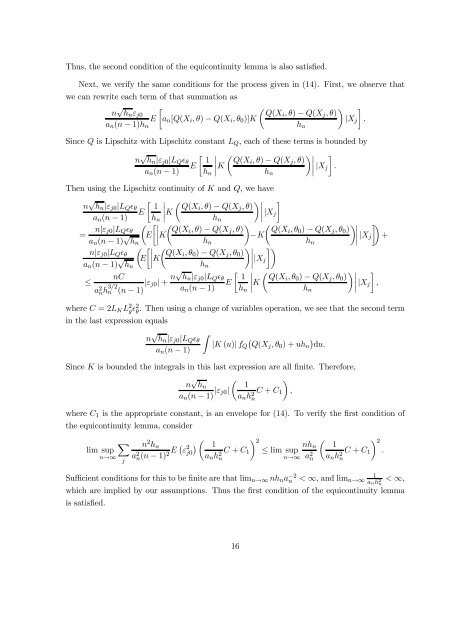On the Identification of Misspecified Propensity Scores - School of ...
On the Identification of Misspecified Propensity Scores - School of ...
On the Identification of Misspecified Propensity Scores - School of ...
Create successful ePaper yourself
Turn your PDF publications into a flip-book with our unique Google optimized e-Paper software.
Thus, <strong>the</strong> second condition <strong>of</strong> <strong>the</strong> equicontinuity lemma is also satisfied.<br />
Next, we verify <strong>the</strong> same conditions for <strong>the</strong> process given in (14). First, we observe that<br />
we can rewrite each term <strong>of</strong> that summation as<br />
n √ hnεj0<br />
E<br />
an(n − 1)hn<br />
<br />
an[Q(Xi, θ) − Q(Xi, θ0)]K<br />
<br />
Q(Xi, θ) − Q(Xj, θ)<br />
|Xj .<br />
Since Q is Lipschitz with Lipschitz constant LQ, each <strong>of</strong> <strong>the</strong>se terms is bounded by<br />
n √ hn|εj0|LQǫθ<br />
an(n − 1) E<br />
<br />
1 <br />
<br />
hn<br />
K <br />
Q(Xi, θ) − Q(Xj, θ) <br />
|Xj .<br />
hn<br />
Then using <strong>the</strong> Lipschitz continuity <strong>of</strong> K and Q, we have<br />
n √ hn|εj0|LQǫθ<br />
an(n − 1) E<br />
<br />
1 <br />
<br />
hn<br />
K <br />
Q(Xi, θ) − Q(Xj, θ) <br />
|Xj<br />
hn<br />
= n|εj0|LQǫθ<br />
an(n − 1) √ <br />
Q(Xi, θ) − Q(Xj, θ) Q(Xi, θ0) − Q(Xj, θ0) <br />
E K<br />
−K<br />
|Xj +<br />
hn<br />
hn<br />
hn<br />
n|εj0|LQǫθ<br />
an(n − 1) √ <br />
Q(Xi, θ0) − Q(Xj, θ0) <br />
E K<br />
|Xj<br />
hn<br />
hn<br />
nC<br />
≤<br />
a2 nh 3/2<br />
n (n − 1) |εj0| + n√hn|εj0|LQǫθ an(n − 1) E<br />
<br />
1 <br />
<br />
hn<br />
K <br />
Q(Xi, θ0) − Q(Xj, θ0) <br />
|Xj ,<br />
hn<br />
where C = 2LKL2 gǫ2 θ . Then using a change <strong>of</strong> variables operation, we see that <strong>the</strong> second term<br />
in <strong>the</strong> last expression equals<br />
n √ hn|εj0|LQǫθ<br />
an(n − 1)<br />
<br />
hn<br />
<br />
|K (u)| fQ Q(Xj, θ0) + uhn du.<br />
Since K is bounded <strong>the</strong> integrals in this last expression are all finite. Therefore,<br />
n √ hn<br />
an(n − 1) |εj0|<br />
<br />
1<br />
<br />
,<br />
anh2 C + C1<br />
n<br />
where C1 is <strong>the</strong> appropriate constant, is an envelope for (14). To verify <strong>the</strong> first condition <strong>of</strong><br />
<strong>the</strong> equicontinuity lemma, consider<br />
n<br />
lim sup<br />
n→∞<br />
j<br />
2hn a2 n(n − 1) 2 E ε 2 <br />
j0<br />
1<br />
anh2 2 nhn<br />
C + C1 ≤ lim sup<br />
n<br />
n→∞ a2 <br />
1<br />
n anh2 2 C + C1 .<br />
n<br />
Sufficient conditions for this to be finite are that limn→∞ nhna −2<br />
n < ∞, and limn→∞ 1<br />
anh 2 n<br />
< ∞,<br />
which are implied by our assumptions. Thus <strong>the</strong> first condition <strong>of</strong> <strong>the</strong> equicontinuity lemma<br />
is satisfied.<br />
16
















